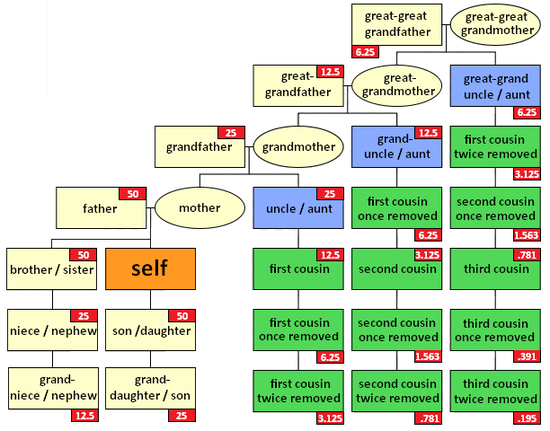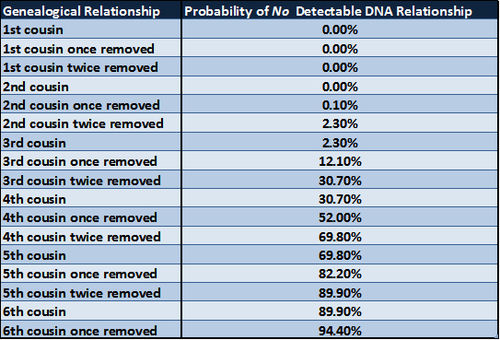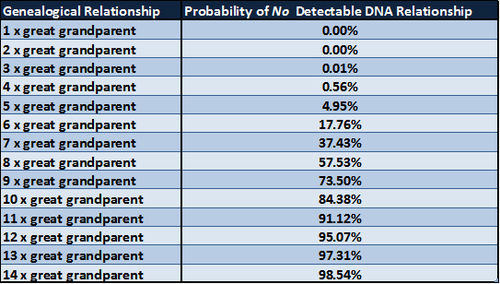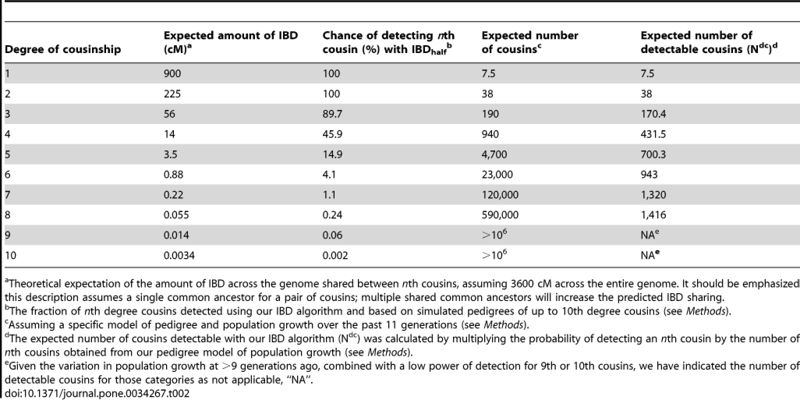Before I start, let me put in a shameless plug for the organization where I found these articles/pages: ISOGG - "International Society of Genetic Genealogy." ISOGG is free to join and has a tremendous amount of resources - I recommend having a look at their pages and I encourage you to join.
Recently, I've had another Wikitree member challenge some of the connections in my tree. Specifically that his line is descended from an ancestor and my line is not. My tree is documented via an iron clad paper trail and the other member has no paper trail. Instead, he has received "hints" from Ancestry.com that he "may" have some cousins who are also descended from this line.
The problem is that the common ancestor is 6 to 8 generations back - for him to have links to cousins who share the same common ancestor, we're looking at a 12 to 16 step connection.
I began to wonder, how many generations back, and how far separated cousins can be matched using autosomal DNA testing?
ISOGG has a very informative page: Autosomal DNA statistics. It was on this page that I found some very interesting and revealing statistics that helped me to understand just how "far back" in time Autosomal DNA testing can be of benefit.
In the chart: Average autosomal DNA shared by pairs of relatives, in percentages and centiMorgans, we see the following data:
| % shared |
Total cM shared half-identical (or better) |
Relationship |
Notes |
| 100% (Method I)/50% (Method II) |
3400.00 |
Identical twins (monozygotic twins) |
Fully identical everywhere.[2] |
| 50% |
3400.00 |
Parent/child |
Half-identical everywhere |
| 50% (Method I)/37.5% (Method II) |
2550.00 |
Full siblings |
Half-identical on 50%/1700 cM and fully identical on a further 25%/850 cM. |
| 25% |
1700.00 |
Grandparent/grandchild, aunt-or-uncle/niece-or-nephew, half-siblings |
|
| 25% (Method I)/23.4375% (Method II) |
1593.75 |
Double first cousins |
Half-identical on 21.875%/1487.5 cM and fully identical on a further 1.5625%/106.25 cM |
| 12.5% |
850.00 |
First cousins, great-grandparent/great-grandchild, great-uncle or aunt/great-nephew or niece, half-uncle or aunt/half-nephew or niece |
|
| 6.25% |
425.00 |
First cousins once removed, half first cousins, great-great-grandparent/great-great-grandchild, great-great-aunt/uncle, half great-aunt/uncle |
|
| 6.25% |
425.00 |
Double second cousins |
|
| 3.125% |
212.50 |
Second cousins, first cousins twice removed, half first cousin once removed, half great-great-aunt/uncle, great-great-great-grandparent/great-great-great-grandchild |
|
| 1.563% |
106.25 |
Second cousins once removed, half second cousins, first cousin three times removed, half first cousin twice removed |
|
| 0.781% |
53.13 |
Third cousins, second cousins twice removed |
Up to 10% of third cousins will not share enough DNA to show up as match. See cousin statistics |
| 0.391% |
26.56 |
Third cousins once removed |
|
| 0.195% |
13.28 |
Fourth cousins, third cousins twice removed |
Up to 50% of fourth cousins will not share enough DNA to show up as match. See cousin statistics |
| 0.0977% |
6.64 |
Fourth cousins once removed. third cousins three times removed |
|
| 0.0488% |
3.32 |
Fifth cousins |
Only between 15% and 32% of fifth cousins will share enough DNA to show up as a match. See cousin statistics |
As I had always thought (roughly calculated in my mind), cousins share about 1/8th DNA on average - some more, some less. And by the end of the chart, we see that by fifth cousins, only between one in three to one in six will share enough DNA to make a match.
And if you have ever seen the "cousin" charts that allow you to quickly determine if your distant cousin is a 3rd or 4th cousin or a 4th cousin twice removed, etc., you'll probably find this chart familiar, except that it shows the average amount of autosomal DNA shared by aunts, uncles, cousins, grandparents, etc:

The page has more charts and stats and is definitely worth a read.
On that page there is also a link to ISOGG's "Cousin Statistics" page. This page is also loaded full of useful data. Two charts stood out to me as very useful in understanding the limits of autosomal DNA searches. They show "the probability that related individuals share some section of genome identical by descent."


And finally, this was an eye opener - how many cousins do you have? Realize, this is based on UK birth rates over the last 200 years. I dare say that the birth rates in the US were likely higher in the same time period and if so, the US stats would dwarf these already spectacularly high counts:
